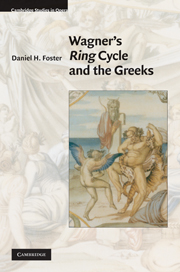Book contents
- Frontmatter
- Contents
- List of musical examples
- Preface
- Acknowledgments
- Introduction
- Part I Epic
- 1 Introduction: what is epic?
- 2 Retrospective narrative and the epic process
- 3 The orchestral narrator and elementary epic
- 4 Spiritual and factual realities in epic
- Part II Lyric
- Part III Drama
- Epilogue: Time, the Ring, and Performance Studies
- Appendices: Wagner's primary and secondary sources
- Notes
- Bibliography
- Index
2 - Retrospective narrative and the epic process
from Part I - Epic
Published online by Cambridge University Press: 07 May 2010
- Frontmatter
- Contents
- List of musical examples
- Preface
- Acknowledgments
- Introduction
- Part I Epic
- 1 Introduction: what is epic?
- 2 Retrospective narrative and the epic process
- 3 The orchestral narrator and elementary epic
- 4 Spiritual and factual realities in epic
- Part II Lyric
- Part III Drama
- Epilogue: Time, the Ring, and Performance Studies
- Appendices: Wagner's primary and secondary sources
- Notes
- Bibliography
- Index
Summary
The influences of Greek epic, lyric, and drama can be found both in the whole and the individual parts of the Ring cycle. Wagner not only patterned each particular opera after a particular genre, he also wove the threads of each genre throughout the whole of the cycle. This is most clearly the case with his use of epic. To many a Wagner scholar and Wagner fan alike, the whole of the Ring seems epic in scope. So much so, that Herbert Lindenberger in his study of operatic excess, Opera: The Extravagant Art, claims, “No work in any art form of the last two centuries, with the exception of a few sprawling novels and films, invites the term epic as readily as the Ring.” For Lindenberger as for others, the epic nature of the Ring resides in its monumentalism as measured from multiple perspectives: time (length of time to plan, write, and perform), size (numbers of performers and space needed), and ideas (claims to universality of message and the greatness of its creator). All of these measurements certainly invite accolades of epic grandeur for the Ring. Further inspired by this Wagnerian monumentalism, we might also be tempted to call the Ring an epic because of the cosmic reach of its plot.
- Type
- Chapter
- Information
- Wagner's Ring Cycle and the Greeks , pp. 45 - 64Publisher: Cambridge University PressPrint publication year: 2010

